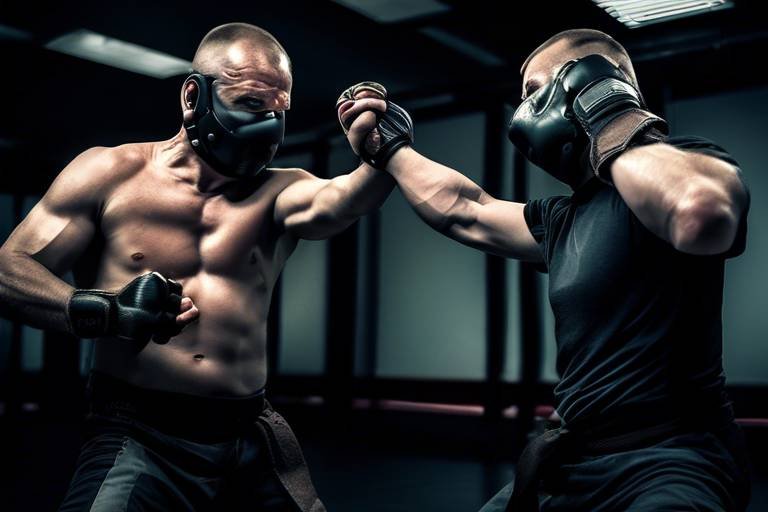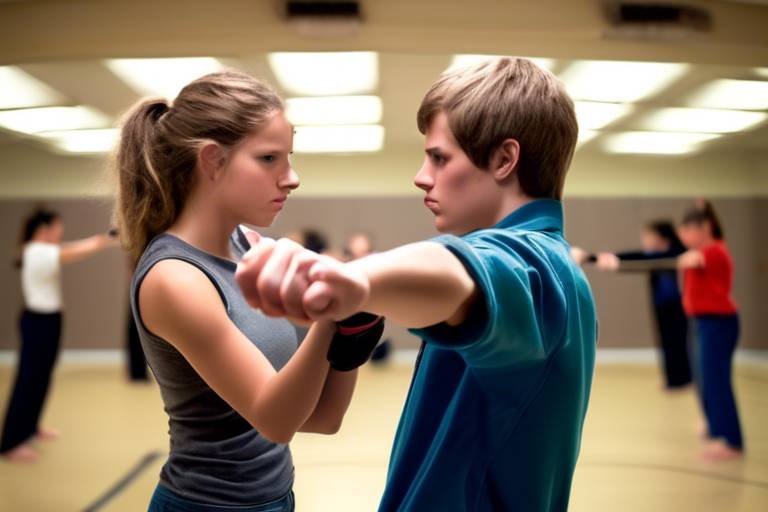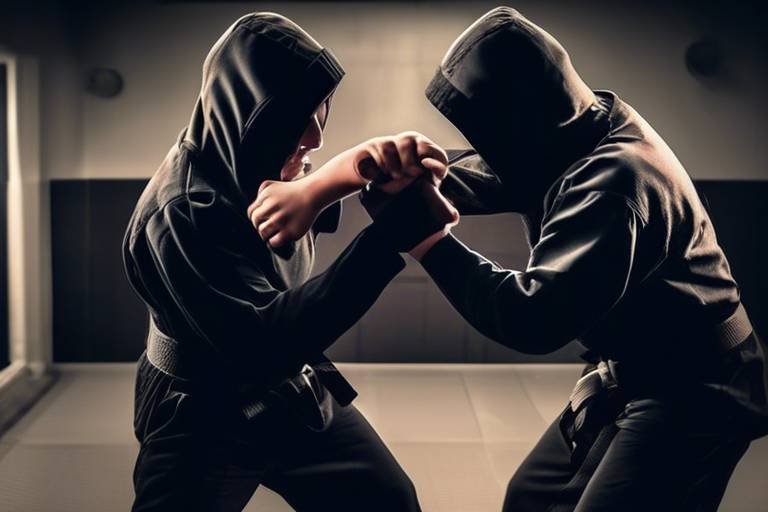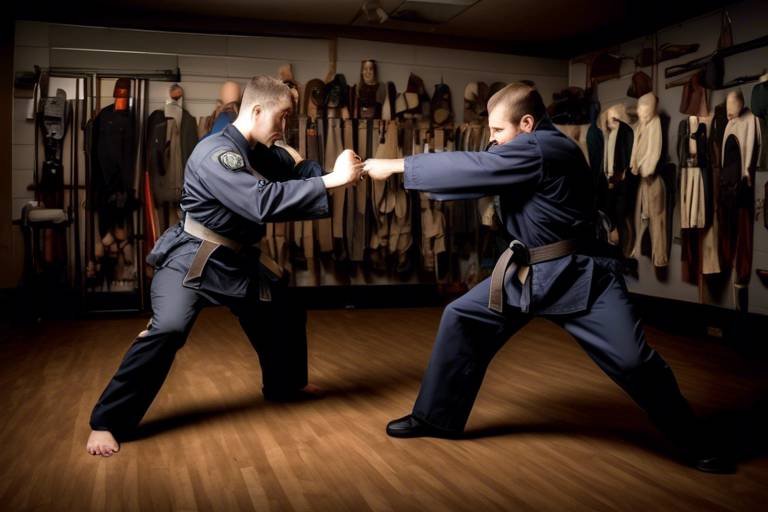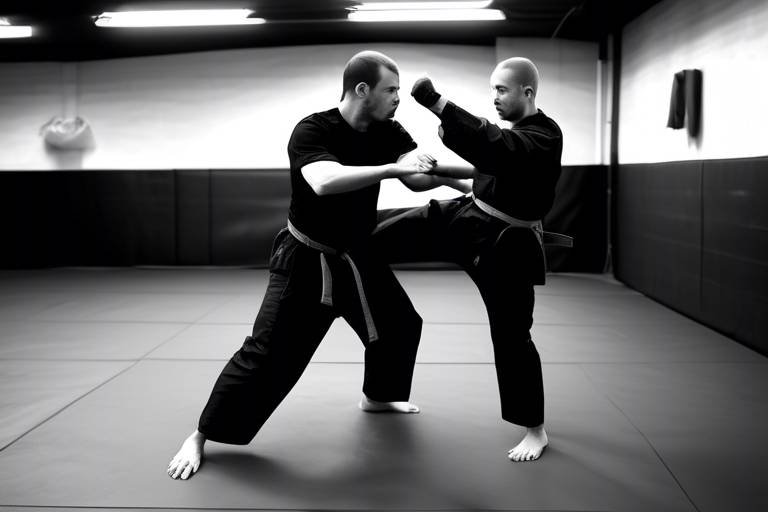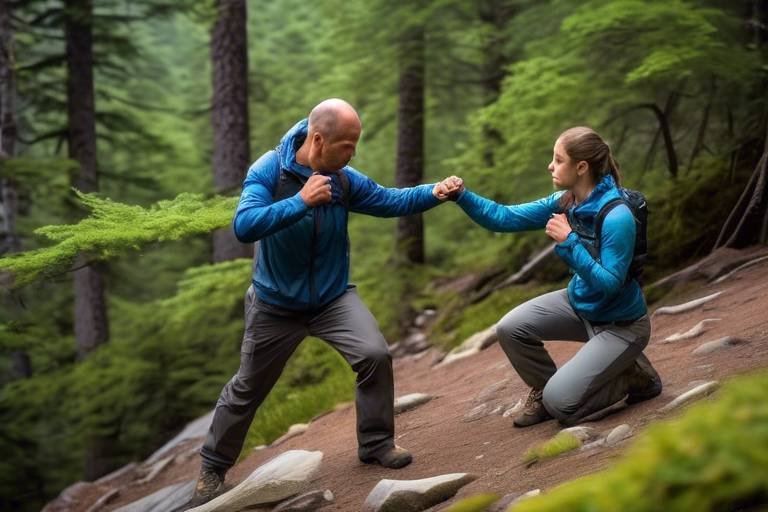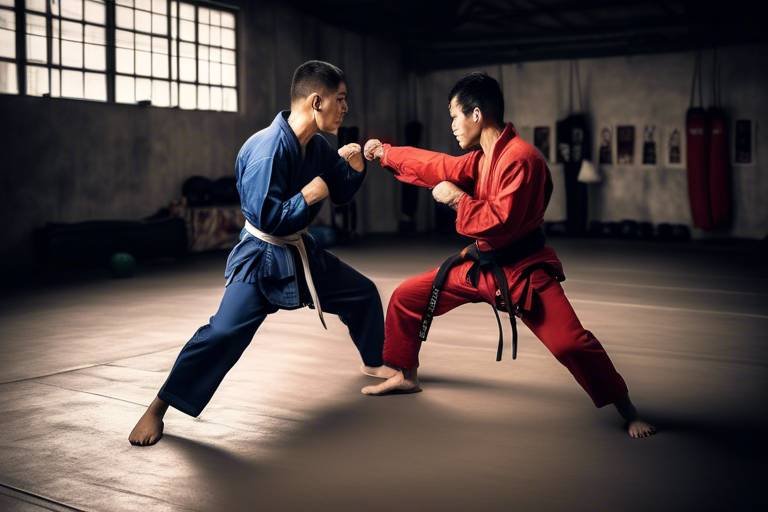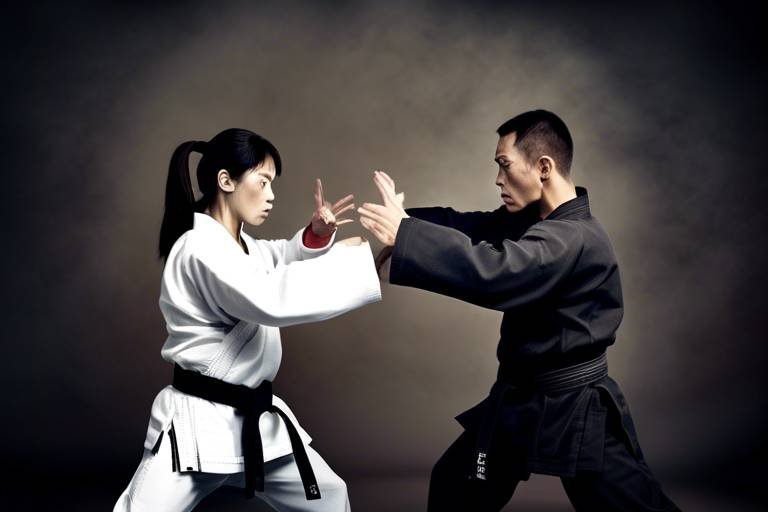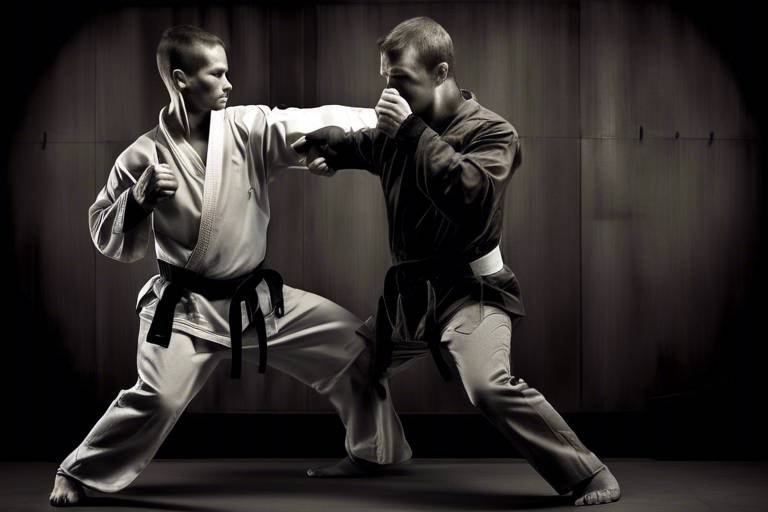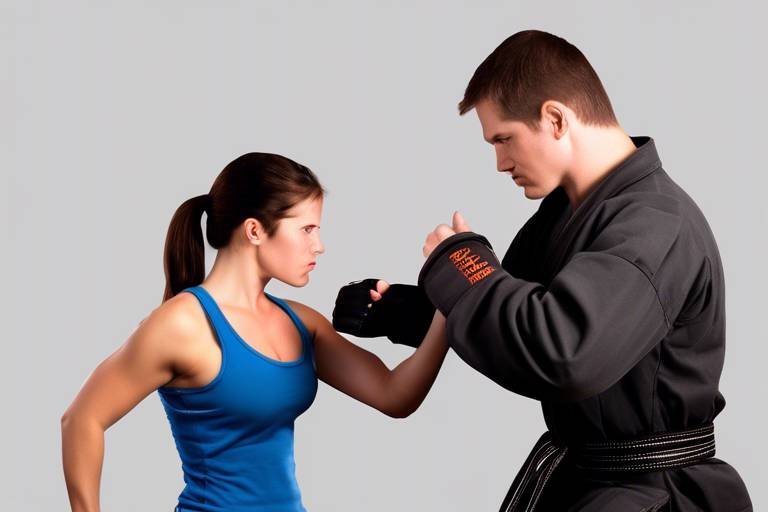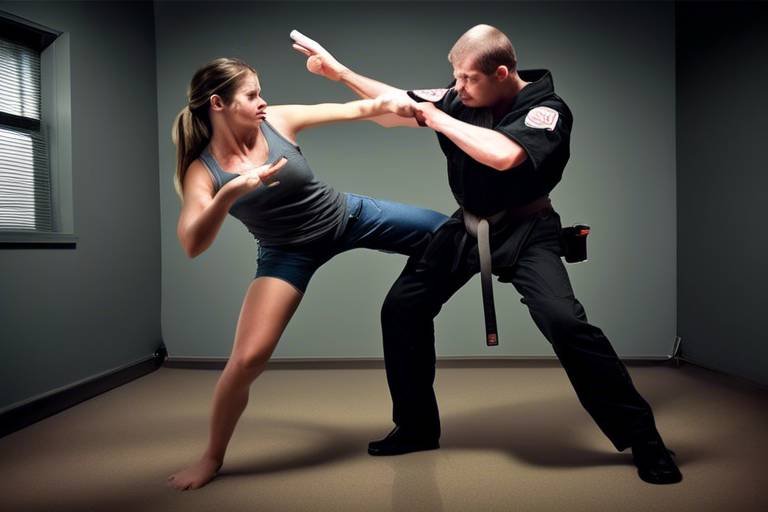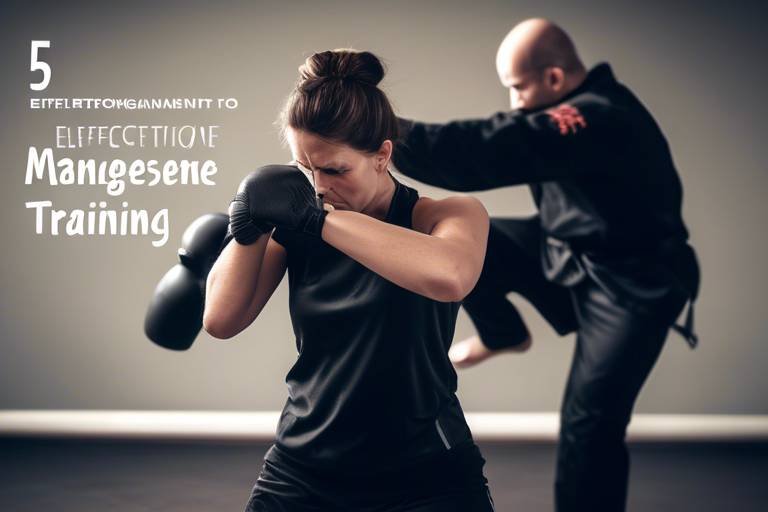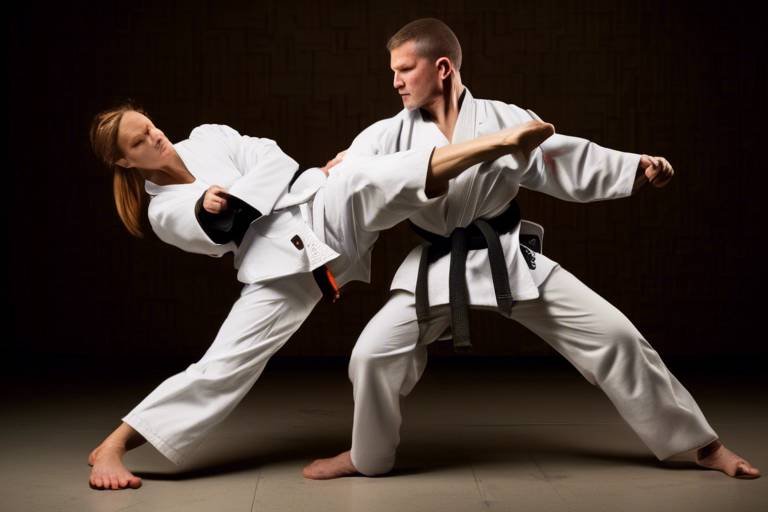Customizing Your Self-Defense Techniques to Your Abilities
In a world where personal safety is paramount, understanding how to tailor self-defense techniques to your unique abilities can make all the difference. It's not just about learning a set of moves; it's about adapting those moves to fit who you are, both physically and mentally. Whether you're a seasoned martial artist or a complete novice, the key is to recognize that self-defense is not a one-size-fits-all approach. Instead, it's a dynamic process that involves assessing your strengths, identifying your weaknesses, and choosing techniques that resonate with your personal capabilities.
Imagine walking into a self-defense class where everyone is told to perform the same moves without consideration for their individual differences. It would be like trying to fit a square peg into a round hole—frustrating and ineffective. The beauty of customizing your self-defense techniques lies in the ability to embrace your unique attributes, whether that means leveraging your agility, focusing on your mental acuity, or adapting to physical limitations. This article will guide you through the process of understanding yourself better and applying that knowledge to develop a self-defense strategy that is not only effective but also empowering.
So, how do you start this journey? It begins with a deep dive into your own capabilities. Are you quick on your feet, or do you have the strength to overpower an assailant? Are you mentally resilient in high-pressure situations, or do you find yourself freezing up? By answering these questions, you'll lay the groundwork for a personalized self-defense plan that enhances your confidence and readiness.
Ultimately, the goal is to create a self-defense method that feels natural to you. This way, when faced with a threat, your body and mind can respond instinctively without hesitation. The techniques you choose should not only reflect your strengths but also address your weaknesses, allowing you to feel secure and capable in any situation. Let's explore how to assess your strengths and weaknesses in detail, paving the way for a customized self-defense strategy.

Understanding Your Strengths
When it comes to self-defense, the first step is to understand your unique strengths. This isn’t just about physical prowess; it encompasses mental resilience, agility, and even intuition. Think of it as a tailor-made suit—if it fits you perfectly, you’ll feel confident and ready to face any challenge. So, how do you start this journey of self-discovery?
First, take a moment to assess your physical capabilities. Are you naturally agile? Do you have a background in sports that gives you an edge in strength or endurance? Perhaps you excel in quick thinking or have a knack for reading situations. These attributes can significantly influence the techniques you choose to master. For example, if you’re quick on your feet, techniques that require rapid movements and evasive actions may suit you best.
Next, consider your mental strengths. Self-defense isn’t solely about physical confrontation; it’s also about mental preparedness. Ask yourself questions like: How do I react under pressure? Am I calm in stressful situations, or do I tend to panic? Recognizing your mental state can help you select techniques that resonate with your natural tendencies. If you’re someone who thrives in high-pressure environments, you might want to focus on techniques that involve quick decision-making and assertiveness.
To make this assessment easier, you can create a simple table to categorize your strengths:
| Type of Strength | Examples | Potential Techniques |
|---|---|---|
| Physical | Agility, Strength, Endurance | Striking, Grappling, Evasion |
| Mental | Calmness, Quick Thinking, Situational Awareness | De-escalation, Assertiveness, Strategic Retreat |
After identifying your strengths, it’s essential to leverage them in your self-defense training. This means choosing techniques that not only align with your physical abilities but also enhance your mental game. For instance, if you know you’re a quick thinker, you might benefit from learning techniques that allow for strategic planning during an encounter. Alternatively, if you have a strong physical presence, focusing on grappling techniques may enhance your effectiveness.
Remember, the key to effective self-defense lies in understanding that you are not a one-size-fits-all fighter. Each person is unique, and recognizing your strengths allows you to tailor your self-defense approach accordingly. So, take the time to reflect on what you bring to the table. This self-awareness will not only boost your confidence but will also prepare you for real-life situations where your strengths can shine.

Identifying Weaknesses
Understanding our weaknesses is just as important as recognizing our strengths when it comes to self-defense. It's like trying to build a house without knowing where the cracks are; you might end up with a structure that's not as sturdy as you think. By identifying personal limitations, we can tailor our self-defense techniques accordingly. This proactive approach not only enhances our safety but also boosts our confidence in handling potential threats.
When we talk about weaknesses, they can manifest in various forms. Some may be physical, while others might be mental or emotional. For instance, if you find yourself easily fatigued or lacking in strength, these are critical factors to consider when choosing your self-defense methods. Recognizing these limitations allows you to adapt your techniques, ensuring that you can still defend yourself effectively even when faced with challenges.
Moreover, the process of identifying weaknesses isn't a one-time activity. It requires ongoing self-assessment and reflection. Here are some common areas to evaluate:
- Physical Limitations: This could include issues like mobility restrictions, lack of strength, or endurance challenges.
- Mental Barriers: Fear, anxiety, or lack of confidence can hinder your ability to respond effectively in a self-defense situation.
- Situational Awareness: Sometimes, being unaware of your surroundings can be a significant disadvantage.
For example, if you have a physical limitation such as a knee injury, it’s essential to adapt your self-defense techniques to avoid putting undue strain on that area. This might mean focusing on techniques that require less mobility or incorporating defensive strategies that allow you to use your environment to your advantage.
Additionally, mental preparedness plays a crucial role in self-defense. If you know that you tend to freeze in high-pressure situations, practicing scenarios that simulate real threats can help you build the mental resilience needed to react effectively. Just like a soldier trains to prepare for battle, you too can condition your mind to respond better when it matters most.
In summary, identifying your weaknesses is a vital step in customizing your self-defense techniques. By being honest with yourself and taking the time to assess your limitations, you can create a personalized self-defense plan that not only maximizes your strengths but also compensates for your weaknesses. Remember, self-defense isn’t about being the strongest or the fastest; it’s about being smart and adaptable.
Q: How can I identify my physical weaknesses for self-defense?
A: Start by evaluating your fitness level and any physical limitations you may have. Consider consulting with a fitness professional who can help you assess your strengths and weaknesses.
Q: What if my weaknesses are mainly mental?
A: Mental weaknesses can be addressed through training and practice. Engaging in self-defense classes can help build your confidence and prepare you for real-life situations.
Q: Is it possible to improve my weaknesses over time?
A: Absolutely! With consistent practice and dedication, you can work on your weaknesses, whether they are physical or mental, and become more proficient in self-defense techniques.

Physical Limitations
Understanding your is essential for effective self-defense. We all have unique bodies, and what works for one person may not work for another. It’s like trying to fit a square peg in a round hole; if you don’t adapt your approach, you might find yourself in trouble. Recognizing these limitations allows you to adjust your techniques, ensuring that you can defend yourself effectively, regardless of your physical condition.
Common physical constraints can include issues such as injuries, chronic pain, or even age-related changes in strength and flexibility. For instance, if you have a past knee injury, executing a high kick might not be the best option for you. Instead, focusing on techniques that require less mobility, such as elbow strikes or knee strikes, can be more effective. The key is to find what works best with your body’s current capabilities.
Moreover, it’s not just about what you can’t do; it’s about leveraging your strengths. For example, if you have a strong upper body but limited leg strength, you might excel in grappling techniques that utilize your arms for control and leverage. This is where creativity comes into play. Self-defense isn’t just about brute strength; it's about using your body wisely and efficiently.
To help you navigate your physical limitations, consider the following adaptations:
- Modify Techniques: Adjust traditional techniques to better suit your abilities. If a move requires a lot of bending or twisting, find a variation that minimizes those motions.
- Focus on Core Strength: A strong core can enhance your balance and stability, allowing you to execute techniques more effectively, even if your limbs have limitations.
- Practice Defensive Maneuvers: Sometimes, simply knowing how to evade an attack can be more valuable than trying to counterattack. Focus on defensive techniques that require less physical exertion.
Ultimately, the goal is to create a personalized self-defense strategy that acknowledges and respects your physical limitations. Remember, self-defense is not about being the strongest or fastest; it's about being smart and prepared. So, take the time to assess your body, understand your limitations, and tailor your self-defense techniques accordingly. By doing so, you’ll not only enhance your safety but also boost your confidence in your ability to protect yourself.

Mobility Issues
When it comes to self-defense, mobility issues can pose significant challenges, but they certainly don't have to limit your ability to protect yourself. Imagine trying to navigate a crowded room while being weighed down by heavy chains—this is what mobility challenges can feel like in a self-defense situation. However, with the right adaptations and mindset, individuals with mobility issues can still effectively defend themselves. The key lies in understanding how to leverage your unique situation to your advantage.
First and foremost, it's essential to recognize that self-defense is not solely about physical strength or speed; it's also about strategy and awareness. Individuals with mobility challenges can focus on techniques that require less physical exertion and more tactical thinking. For instance, utilizing your environment can be a game changer. Look for objects around you that can serve as barriers or shields, or even as tools for self-defense. A sturdy bag or an umbrella can be used to create distance between you and an attacker, allowing you to escape without engaging directly.
Moreover, adapting your stance and movement can significantly enhance your self-defense capabilities. Here are a few practical adaptations:
- Staying Grounded: Instead of trying to move quickly, focus on maintaining a stable base. This will help you remain balanced and ready to react.
- Using Upper Body Techniques: Techniques that rely on upper body strength, such as strikes with elbows or hands, can be more effective than kicks or other lower-body movements.
- Defensive Postures: Learn to adopt defensive postures that protect vital areas while allowing you to move your upper body effectively.
In addition to physical adaptations, mental preparedness is crucial. Building confidence in your ability to respond to threats can dramatically improve your overall effectiveness in self-defense situations. Consider practicing visualization techniques where you mentally rehearse different scenarios. This can help you feel more prepared and less anxious when faced with a real-life situation.
Lastly, remember that self-defense is not just about fighting back; it's equally about avoiding confrontation whenever possible. Being aware of your surroundings and recognizing potential threats can help you steer clear of danger altogether. In essence, while mobility issues may require some adjustments in your approach to self-defense, they do not diminish your ability to protect yourself. By focusing on strategy, adapting techniques, and fostering mental resilience, you can empower yourself to face any challenge head-on.
Q1: Can I learn self-defense if I have mobility issues?
A1: Absolutely! Self-defense can be tailored to accommodate mobility issues. Focus on techniques that leverage your strengths and adapt movements to suit your capabilities.
Q2: What are some effective self-defense techniques for someone with limited mobility?
A2: Techniques that emphasize upper body strength, defensive postures, and environmental awareness can be very effective. Consider practicing strikes with the hands or elbows and using objects around you for protection.
Q3: How can I build confidence in my self-defense abilities?
A3: Mental preparedness is key. Practice visualization techniques and role-play different scenarios to build confidence. Training with a trusted partner can also help you feel more secure.
Q4: Is it necessary to be physically fit to learn self-defense?
A4: While physical fitness can enhance your self-defense capabilities, it is not a strict requirement. Many self-defense techniques focus on strategy and awareness, which can be effective regardless of fitness level.

Strength and Endurance
When it comes to self-defense, strength and endurance are not just about physical power; they are vital components that can significantly enhance your ability to defend yourself effectively. Think of your body as a finely-tuned machine. If one part is weak or underperforming, the entire system can falter. Therefore, understanding how to modify your self-defense techniques based on your unique fitness levels is essential.
First off, let’s talk about strength. It’s easy to assume that self-defense is all about brute force, but the reality is that technique often trumps strength. However, having a good base level of strength allows you to execute techniques more effectively. For instance, if you have a stronger grip, you can better control an attacker’s limbs during a confrontation. On the other hand, if your strength is limited, you might focus more on techniques that utilize leverage and body mechanics rather than raw power. This is where the concept of using your opponent's energy against them comes into play.
Now, let’s consider endurance. Imagine being in a high-stress situation where you need to defend yourself. If you tire out quickly, your ability to react effectively diminishes dramatically. Building your endurance can mean the difference between escaping a dangerous situation and becoming overwhelmed. Incorporating cardio exercises, such as running, swimming, or cycling, can improve your stamina. This way, you can maintain your energy levels during a confrontation, allowing you to think clearly and react swiftly.
To better understand how strength and endurance can be tailored to your self-defense training, let’s look at a simple table that outlines some effective exercises:
| Exercise | Focus Area | Benefits |
|---|---|---|
| Push-ups | Upper Body Strength | Improves upper body strength for better control during grappling. |
| Squats | Lower Body Strength | Enhances leg strength for powerful kicks and stability. |
| Burpees | Full Body Endurance | Boosts overall endurance and agility, essential for quick movements. |
| Interval Training | Cardiovascular Endurance | Improves stamina and recovery time, allowing for sustained effort. |
Incorporating these exercises into your routine can help you build the necessary strength and endurance for self-defense. Remember, the goal isn’t just to become a powerhouse but to develop a balanced approach that plays to your strengths while addressing your weaknesses.
Ultimately, self-defense is about being prepared, both physically and mentally. By focusing on strength and endurance, you are not just enhancing your physical capabilities but also boosting your confidence. When you know you can hold your own, you’re more likely to stand tall and face a threat head-on. So, whether you’re lifting weights, going for a run, or practicing techniques, always keep in mind how these elements contribute to your overall self-defense strategy.
- What are the best exercises for building self-defense strength?
Exercises like push-ups, squats, and deadlifts are excellent for building overall strength. They help you develop the muscles you'll rely on during a self-defense situation.
- How can I improve my endurance for self-defense?
Incorporate cardiovascular workouts such as running, cycling, or swimming into your routine. High-intensity interval training (HIIT) can also be very effective.
- Is it necessary to have a lot of strength to defend myself?
No, while strength can help, effective self-defense techniques often rely more on skill and strategy than on physical power alone.

Mental Preparedness
Mental preparedness is often the unsung hero in the realm of self-defense. You might have the physical prowess of a martial artist, but if your mind isn't ready to respond to a threat, all that training can go out the window. Think of your mind as the command center of your body; if it's not functioning optimally, your responses may falter. So, how do we cultivate this mental readiness? It starts with understanding that self-defense isn't just about physical techniques; it's also about psychological strategies that can make a world of difference in high-pressure situations.
One effective way to enhance mental preparedness is through visualization techniques. Imagine yourself in a threatening scenario, and picture how you would respond. This mental rehearsal can help you feel more confident and less anxious when faced with real-life situations. Just like athletes visualize their performances before a big game, you can use this technique to mentally prepare yourself for potential confrontations. It’s about creating a mental blueprint that you can rely on when the adrenaline kicks in.
Additionally, building confidence can be achieved through regular training and practice. The more familiar you become with self-defense techniques, the more automatic your responses will be. This familiarity breeds a sense of security that can significantly reduce panic in stressful situations. Consider incorporating drills that simulate real-life scenarios, allowing you to practice your reactions in a controlled environment. Over time, this will enhance your ability to think clearly under pressure.
Another aspect of mental preparedness is developing resilience. Life can throw unexpected challenges your way, and the ability to bounce back from setbacks is crucial not only in self-defense but in everyday life. Resilience can be cultivated by facing small challenges regularly—whether it's pushing through a tough workout or stepping outside your comfort zone in social situations. Each time you overcome a challenge, you build a mental toolkit that can be invaluable when facing more significant threats.
Finally, it’s essential to understand your emotional responses to fear and stress. Recognizing how your body reacts in high-pressure situations can help you manage those feelings. For example, if you know that your heart races and your palms sweat when you're scared, you can implement calming techniques, such as deep breathing, to regain control. By practicing these techniques regularly, you train your mind to remain calm and focused, even in the heat of the moment.
In summary, mental preparedness is a multifaceted approach that encompasses visualization, confidence-building, resilience, and emotional awareness. By investing time and effort into these areas, you can significantly enhance your self-defense capabilities. Remember, the mind is a powerful ally in ensuring your safety, so don’t underestimate its importance!
- What is mental preparedness in self-defense? Mental preparedness refers to the psychological readiness to respond effectively to threats, encompassing techniques like visualization and confidence-building.
- How can I improve my mental preparedness? You can improve mental preparedness through visualization exercises, regular practice, and resilience-building activities.
- Why is mental preparedness as important as physical training? Because in high-pressure situations, a clear and focused mind can enhance your ability to execute physical techniques effectively.
- Can emotional awareness help in self-defense? Yes, understanding your emotional responses can help you manage fear and stress, allowing for clearer thinking during confrontations.

Choosing the Right Techniques
When it comes to self-defense, the importance of selecting the right techniques cannot be overstated. It’s not just about knowing a few moves; it’s about understanding what works best for you, given your unique blend of physical and mental capabilities. So, how do you go about making these choices? The first step is to evaluate your strengths and weaknesses, which we discussed earlier. But beyond that, you need to consider the context in which you might find yourself needing to defend yourself. For example, are you more likely to face an attacker in a crowded area or a secluded space? Each scenario demands a different approach.
Moreover, understanding the various self-defense styles available is essential. From Brazilian Jiu-Jitsu to Krav Maga, each discipline offers unique techniques that can be tailored to fit your personal abilities. For instance, if you are smaller in stature, you might find that styles focusing on leverage and technique—like Jiu-Jitsu—allow you to defend yourself effectively against larger opponents. On the other hand, if you possess a strong background in striking, you might lean towards boxing or Muay Thai, which can capitalize on your strengths.
But it doesn’t stop there! The techniques you choose should also resonate with your personal comfort level. If you feel uneasy about a particular move or style, it’s likely that hesitation will creep in during a real-life situation. You want to feel confident and at ease with your chosen methods, as this will directly impact your ability to react effectively when it matters most. Think of it like choosing a pair of shoes; you wouldn’t pick a style that pinches your toes or feels awkward. Instead, you’d opt for something that fits well and allows you to move freely.
Here’s a quick table summarizing some popular self-defense techniques and their suitability based on different strengths:
| Technique | Best For | Key Features |
|---|---|---|
| Brazilian Jiu-Jitsu | Smaller individuals | Focuses on leverage and submission holds |
| Krav Maga | Real-world scenarios | Emphasizes quick, effective strikes and escapes |
| Boxing | Strikers | Enhances footwork and hand speed |
| Karate | Discipline and focus | Combines striking with mental training |
In addition to selecting techniques based on your physical attributes, consider the mental aspect of self-defense. Techniques that require a high degree of situational awareness or quick decision-making may be more suited for those who thrive under pressure. If you're someone who prefers a more methodical approach, techniques that allow for planning and strategy, like Judo, may suit you better.
Ultimately, the key to effective self-defense lies in your ability to adapt and modify techniques to fit your personal style. This adaptability not only enhances your confidence but also ensures that you can respond effectively in various scenarios. Remember, it’s not about mastering every technique out there; it’s about mastering the ones that resonate with you. So, take the time to explore, practice, and refine your skills. Your safety depends on it!
- What if I have no prior experience in self-defense? Don’t worry! Many self-defense classes cater to beginners, focusing on fundamental techniques that anyone can learn.
- How often should I practice? Regular practice is essential. Aim for at least once a week to keep your skills sharp.
- Can self-defense techniques be learned online? While online resources can be helpful, it’s best to learn from a qualified instructor to ensure proper technique and safety.
- Is self-defense training suitable for all ages? Absolutely! There are programs designed for children, teens, and adults, each tailored to their capabilities.

Popular Self-Defense Styles
When it comes to self-defense, the variety of styles available can be as overwhelming as choosing what to wear on a first date. Each style has its own unique flavor, and finding the right fit for your personal abilities and preferences is key to effective self-defense. Let's dive into some of the most popular self-defense styles and see how they can be tailored to suit your individual strengths.
First off, we have Karate. This traditional martial art focuses on striking techniques, including punches, kicks, and knee strikes. If you have a knack for speed and agility, Karate could be a fantastic option for you. The beauty of Karate lies in its emphasis on discipline and mental focus, which can help boost your confidence in high-pressure situations. Plus, the practice of katas—pre-arranged forms—can enhance your muscle memory, making your responses more instinctive.
Next up is Brazilian Jiu-Jitsu (BJJ). This grappling-based martial art is all about leverage and technique rather than brute strength. If you find yourself on the smaller side or perhaps lack the upper body strength, BJJ could be your best friend. It teaches you how to control an opponent through positioning and submissions, making it an ideal choice for those who prefer to use their wits over raw power. The adaptability of BJJ allows practitioners to modify techniques based on their physical capabilities, making it accessible for almost anyone.
Another great option is Muay Thai, often referred to as the "Art of Eight Limbs." This striking art utilizes punches, kicks, elbows, and knee strikes, providing a well-rounded approach to self-defense. If you have a solid fitness level and enjoy high-intensity workouts, Muay Thai can enhance your strength and endurance while teaching you effective striking techniques. The conditioning involved in Muay Thai training also helps build resilience, which is crucial in self-defense situations.
For those who prefer a more fluid and graceful approach, Tai Chi might be the answer. Often seen as a meditative practice, Tai Chi teaches balance, control, and awareness. While it may not seem like a conventional self-defense style, its principles of redirecting energy and using an opponent's force against them can be incredibly effective. If you have mobility issues or are looking for a low-impact option, Tai Chi can be adapted to suit your needs while still providing valuable self-defense techniques.
Lastly, let’s not forget about Krava Maga, the Israeli martial art known for its practical and no-nonsense approach to self-defense. This style focuses on real-world situations and teaches techniques that can be applied quickly and efficiently. If you’re someone who thrives under pressure and wants to learn how to respond to threats without hesitation, Krava Maga might be your go-to. Its emphasis on situational awareness and quick decision-making can make it a powerful tool for anyone looking to enhance their self-defense skills.
In conclusion, the world of self-defense styles is rich and varied, offering something for everyone. Whether you lean towards striking arts like Karate and Muay Thai, grappling techniques in Brazilian Jiu-Jitsu, or the graceful movements of Tai Chi, the key is to find a style that resonates with you. Remember, the best self-defense technique is the one that you feel comfortable and confident using. So, don’t hesitate to try a few classes and see which style fits you best!
- What is the best self-defense style for beginners? Many beginners find Karate or Brazilian Jiu-Jitsu to be approachable, as they focus on fundamental techniques and build confidence.
- Can I practice self-defense if I have physical limitations? Absolutely! Many styles, like Tai Chi and adapted Brazilian Jiu-Jitsu, can be tailored to accommodate various physical abilities.
- How long does it take to become proficient in self-defense? Proficiency varies by individual and style, but regular practice over several months can significantly enhance your skills.
- Is self-defense training only for women? No! Self-defense training is beneficial for individuals of all genders and ages, empowering everyone to protect themselves.

Training for Adaptability
When it comes to self-defense, one of the most crucial aspects is the ability to adapt to various situations. Training for adaptability is not just about learning a set of moves; it's about developing a mindset that allows you to respond effectively, regardless of the circumstances. Think of it like a chameleon that changes its colors based on its environment—your self-defense techniques should be just as flexible. By engaging in diverse training methods, you can enhance your ability to adjust your responses based on your surroundings and the threats you face.
One effective way to train for adaptability is by practicing in differing environments. For instance, try simulating self-defense scenarios in various settings, such as a crowded area, a narrow hallway, or even outdoors. Each environment presents unique challenges and requires different strategies. This kind of training helps you become more comfortable with the unexpected and teaches you how to think on your feet. Just like a seasoned actor who can perform on any stage, you too can become proficient in adapting your techniques to fit the situation.
Additionally, incorporating varied training partners into your practice can significantly enhance your adaptability. Each person brings different strengths, weaknesses, and fighting styles to the table. By sparring or practicing techniques with a diverse group of partners, you expose yourself to a range of movements and reactions. This way, you learn to adjust your strategies on the fly, which is invaluable during a real-life confrontation. Remember, a one-size-fits-all approach rarely works in self-defense, so embrace the diversity of your training partners.
Another key element is to focus on mental agility. Self-defense is as much about your mental state as it is about physical prowess. Consider incorporating drills that require quick thinking and decision-making under pressure. For example, you might practice responding to a surprise attack from different angles or with different levels of aggression. This not only sharpens your physical responses but also boosts your confidence in handling unexpected situations. Just like a chess player anticipates their opponent's moves, you should train your mind to foresee potential threats and respond accordingly.
Finally, don't underestimate the power of reflection and analysis. After each training session, take a moment to evaluate what worked well and what didn’t. Keeping a training journal can be incredibly beneficial. Document your experiences, noting down specific scenarios where you felt adaptable and others where you struggled. This self-reflection will help you identify patterns in your behavior and areas for improvement. Think of it as a personal roadmap that guides you towards becoming a more adaptable self-defender.
In summary, training for adaptability in self-defense is about embracing flexibility in both your physical techniques and mental strategies. By exposing yourself to varied environments, practicing with different partners, enhancing your mental agility, and reflecting on your experiences, you can cultivate a robust self-defense skill set. This adaptability not only increases your effectiveness in self-defense situations but also boosts your overall confidence and resilience.
- What is the best way to train for adaptability in self-defense?
Engage in diverse training environments, practice with various partners, and incorporate mental agility drills into your routine. - How can I improve my mental preparedness for self-defense?
Focus on visualization techniques, role-playing scenarios, and practicing mindfulness to enhance your mental resilience. - Is it necessary to train with different styles of self-defense?
Yes, training in various styles can provide a broader perspective and help you find techniques that suit your personal strengths.
Frequently Asked Questions
- What are the best self-defense techniques for beginners?
For beginners, it's essential to start with basic techniques that focus on awareness and simple defensive moves. Techniques like escaping wrist grabs, using your voice to deter an attacker, and practicing situational awareness can be very effective. As you build confidence, you can explore more advanced techniques that suit your personal strengths.
- How can I assess my physical strengths for self-defense?
Assessing your physical strengths involves understanding your body mechanics and fitness level. You can start by identifying activities you excel at, whether it's running, grappling, or striking. Consider engaging in fitness assessments or self-defense classes that focus on your strengths, helping you tailor techniques that leverage your unique abilities.
- What should I do if I have mobility issues?
If you have mobility issues, it's crucial to adapt self-defense techniques to your capabilities. Focus on techniques that require minimal movement, such as using your voice effectively, creating distance, or employing strategic positioning. There are also specific self-defense classes designed for individuals with mobility challenges, ensuring you can still protect yourself effectively.
- How can I improve my mental preparedness for self-defense?
Improving mental preparedness involves practicing visualization techniques, role-playing scenarios, and building confidence through training. Engaging in mindfulness exercises can also help you stay calm under pressure. Remember, the more you prepare mentally, the better you'll respond in high-stress situations.
- Are there specific self-defense styles that are better for women?
While self-defense is effective for everyone, some styles may resonate more with women due to their emphasis on leverage and technique over brute strength. Styles like Krav Maga, Brazilian Jiu-Jitsu, and Aikido focus on using an opponent's energy against them, making them accessible and effective for women of all sizes and strengths.
- How often should I train to stay effective in self-defense?
Consistency is key in self-defense training. Aim to practice at least once or twice a week to maintain your skills and build muscle memory. Additionally, incorporating physical fitness into your routine will enhance your overall effectiveness and readiness to respond to threats.
- Can self-defense techniques be adapted for different situations?
Absolutely! One of the core principles of self-defense is adaptability. Techniques should be flexible enough to apply in various scenarios, whether it's a close-quarters confrontation or a more open environment. Training in diverse situations will help you learn how to adjust your techniques based on the circumstances you face.

